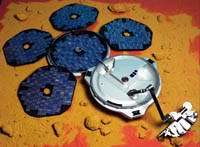Internal Beagle 2 Failure Investigation

The European Space Agency's Mars Express spacecraft dropped the tiny, 30-kilogram Beagle 2 lander onto the Martian surface on December 25, 2003. Beagle 2 carried a powerful suite of instruments that it would have used to study the geology and climate at its landing site and to search for evidence of life, extinct or extant, on Mars.
Two open reports have been published by the Beagle 2 Project Team after a six-month internal investigation.
The Beagle 2 Mission Report - which describes the flight operations and reports on the possible failure modes that may have prevented the Lander from returning a signal on December 25, 2003.
'Lessons Learned' - a complete list of lessons learned from the mission as a guide for future missions.
The two reports have been produced by the Beagle 2 team and consequently are not endorsed by PPARC, ESA or any other agency. They have been produced as a record of the internal Beagle 2 investigation.
Since December 25, 2003, the combined academic/industry Mission Operations team from the University of Leicester, EADS-Astrium and SciSys based at the National Space Centre in Leicester has been analysing data from Beagle 2 and since February 2004 conducting an internal enquiry into possible reasons for the non-fulfilment of the mission.
The result is the Mission Report, which includes contributions and input from the Open University, ESA and a number of other sources. Because no data was received from Beagle 2 following its successful ejection from Mars Express on December 19, 2003, it is not possible to identify an exact failure mode. However the Mission Report highlights a number of possibilities. Beagle 2 probably failed some where in the time critical and high risk phase of entry, descent and landing. The Mission Report analyses all identified potential failure modes and identify a subset that could be probable causes.
As a result of the non-fulfilment of the mission a number of Lessons Learned has been compiled and documented as a guide to making any Mars Lander mission more robust in the future. In addition the document also addresses a number of points regarding the management and programmatics of the Beagle 2 programme to clarify and address a number of issues raised elsewhere.
These reports represent the end of the first mission for Beagle 2. The team hopes however that the concept of small Mars Landers will not die with Beagle 2 and that the payload will fly again to conduct the world class science planned for the mission and that the technology developed will be used in future missions.
About Beagle 2:
Science Objectives
- Search for evidence of, and conditions for, past life
- Seek trace atmospheric species indicative of extant life
- Measure the composition of the atmosphere and monitor diurnal and seasonal changes in temperature, pressure, wind speed, UV flux, oxidation potential, dust environment etc.
- Investigate the oxidative state of the martian surface, rock interiors and beneath boulders.
- Examine the chemistry, mineralogy, petrology and age of rocks
- Characterize the geomorphology of the landing site
Scientific Instruments
- GAP (Gas Analysis Package)
- A pair of stereoscopic cameras
- A wide-angle camera
- PLUTO (Planetary Undersurface Tool), a "mole" sample collection device
- A robotic arm carrying a microscopic imaging camera, an X-ray detector, a Mössbauer Spectrometer, and a rock grinder and corer
- A suite of seven environmental sensors
With a landed mass of 33.2kg, Beagle 2 represents the most ambitious science payload to systems mass ratio ever attempted. Almost a third of the payload will carry out various types of analysis or be used to manipulate and collect samples for study on the surface of Mars.
Beagle 2 is not just small it has a high concentration of scientific instruments. Because of a highly integrated approach this leads to Beagle 2 comparing favourably with other landers both actual and proposed for a variety of solar system locations.
Beagle 2 had a robotic arm known as the Payload Adjustable Workbench (PAW), designed to be extended after landing. The PAW contained a pair of stereo cameras, a microscope (with a 6 micrometre resolution), a Mössbauer spectrometer, an X-ray spectrometer, a drill for collecting rock samples and a spotlamp. Rock samples were to be passed by the PAW into a mass spectrometer and gas chromatograph in the body of the lander, to measure the relative proportions of different isotopes of carbon. Since carbon is thought to be the basis of all life, these readings could have revealed whether the samples contained the remnants of living organisms.
In addition, Beagle 2 was equipped with a small "mole" (Planetary Undersurface Tool, or PLUTO), to be deployed by the arm. PLUTO had a compressed spring mechanism designed to enable it to move across the surface at a rate of about 1 cm every 5 seconds and to burrow into the ground and collect a subsurface sample in a cavity in its tip. The mole was attached to the lander by a power cable which could be used as a winch to bring the sample back to the lander.
The robot arm was equipped with a grinder and corer, a device to collect a core sample from inside any rocks within reach of the robot arm. The lander had the shape of a shallow bowl with a diameter of 0.65 m and a depth of 0.25 m. The cover of the lander was hinged and folded open to reveal the interior of the craft which holds a UHF antenna, the 0.75 m long robot arm, and the scientific equipment. The main body also contained the battery, telecommunications, electronics, and central processor, and the heaters. The lid itself further unfolded to expose four disk-shaped solar arrays. The lander package had a mass of 69 kg at launch but the actual lander would have been only 33.2 kg at touchdown.

















